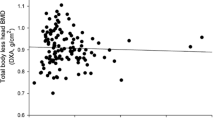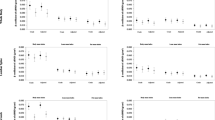Abstract
The aim of this study was to investigate the relationship between markers of body fat and bone status assessed as calcaneal bone stiffness in a large sample of European healthy pre- and primary school children. Participants were 7,447 children from the IDEFICS study (spread over eight different European countries), age 6.1 ± 1.8 years (range 2.1–9.9), 50.5 % boys. Anthropometric measurements (weight, height, bioelectrical impedance, waist and hip circumference, and tricipital and subscapular skinfold thickness) as well as quantitative ultrasonographic measurements to determine calcaneal stiffness index (SI) were performed. Partial correlation analysis, linear regression analysis, and ANCOVA were stratified by sex and age group: preschool boys (n = 1,699) and girls (n = 1,599) and primary school boys (n = 2,062) and girls (n = 2,087). In the overall study population, the average calcaneal SI was equal to 80.2 ± 14.0, ranging 42.4–153. The results showed that preschool children with higher body fat had lower calcaneal SI (significant correlation coefficients between −0.05 and −0.20), while primary school children with higher body fat had higher calcaneal SI (significant correlation coefficients between 0.05 and 0.13). After adjusting for fat-free mass, both preschool and primary school children showed an inverse relationship between body fat and calcaneal stiffness. To conclude, body fat is negatively associated with calcaneal bone stiffness in children after adjustment for fat-free mass. Fat-free mass may confound the association in primary school children but not in preschool children. Muscle mass may therefore be an important determinant of bone stiffness.


Similar content being viewed by others
References
Schoenau E, Saggese G, Peter F, Baroncelli GI, Shaw NJ, Crabtree NJ, Zadik Z, Neu CM, Noordam C, Radetti G, Hochberg Z (2004) From bone biology to bone analysis. Horm Res 61:257–269
Binkley TL, Berry R, Specker BL (2008) Methods for measurement of pediatric bone. Rev Endocr Metab Dis 9:95–106
Wunsche K, Wunsche B, Fahnrich H, Mentzel HJ, Vogt S, Abendroth K, Kaiser WA (2000) Ultrasound bone densitometry of the os calcis in children and adolescents. Calcif Tissue Int 67:349–355
Rizzoli R, Bianchi ML, Garabedian M, Mckay HA, Moreno LA (2010) Maximizing bone mineral mass gain during growth for the prevention of fractures in the adolescents and the elderly. Bone 46:294–305
Leonard MB, Shults J, Wilson BA, Tershakovec AM, Zemel BS (2004) Obesity during childhood and adolescence augments bone mass and bone dimensions. Am J Clin Nutr 80:514–523
Gracia-Marco L, Ortega FB, Jimenez-Pavon D, Rodriguez G, Castillo MJ, Vicente-Rodriguez G, Moreno LA (2011) Adiposity and bone health in Spanish adolescents. The HELENA study. Osteoporos Int 23:937–947
Ellis KJ, Shypailo RJ, Wong WW, Abrams SA (2003) Bone mineral mass in overweight and obese children: diminished or enhanced? Acta Diabetol 40(Suppl 1):S274–S277
Falk B, Braid S, Moore M, O’Leary D, Sullivan P, Klentrou P (2008) Bone properties in overweight pre- and early-pubertal boys. Pediatr Exerc Sci 20:50–61
Goulding A, Taylor RW, Jones IE, McAuley KA, Manning PJ, Williams SM (2000) Overweight and obese children have low bone mass and area for their weight. Int J Obes Relat Metab Disord 24:627–632
Rocher E, Chappard C, Jaffre C, Benhamou CL, Courteix D (2008) Bone mineral density in prepubertal obese and control children: relation to body weight, lean mass, and fat mass. J Bone Miner Metab 26:73–78
Duquette J, Lin J, Hoffman A, Houde J, Ahmadi S, Baran D (1997) Correlations among bone mineral density, broadband ultrasound attenuation, mechanical indentation testing, and bone orientation in bovine femoral neck samples. Calcif Tissue Int 60:181–186
Baroncelli GI (2008) Quantitative ultrasound methods to assess bone mineral status in children: technical characteristics, performance, and clinical application. Pediatr Res 63:220–228
Goh SY, Aragon JM, Lee YS, Loke KY (2011) Normative data for quantitative calcaneal ultrasound in Asian children. Ann Acad Med Singap 40:74–76
Falcini F, Bindi G, Ermini M, Galluzzi F, Poggi G, Rossi S, Masi L, Cimaz R, Brandi ML (2000) Comparison of quantitative calcaneal ultrasound and dual energy X-ray absorptiometry in the evaluation of osteoporotic risk in children with chronic rheumatic diseases. Calcif Tissue Int 67:19–23
Fielding KT, Nix DA, Bachrach LK (2003) Comparison of calcaneus ultrasound and dual X-ray absorptiometry in children at risk of osteopenia. J Clin Densitom 6:7–15
Gluer CC, Wu CY, Jergas M, Goldstein SA, Genant HK (1994) Three quantitative ultrasound parameters reflect bone structure. Calcif Tissue Int 55:46–52
Njeh CF, Hans D, Wu C, Kantorovich E, Sister M, Fuerst T, Genant HK (1999) An in vitro investigation of the dependence on sample thickness of the speed of sound along the specimen. Med Eng Phys 21:651–659
Jaworski M, Lebiedowski M, Lorenc RS, Trempe J (1995) Ultrasound bone-measurement in pediatric subjects. Calcif Tissue Int 56:368–371
Mughal MZ, Langton CM, Utretch G, Morrison J, Specker BL (1996) Comparison between broad-band ultrasound attenuation of the calcaneum and total body bone mineral density in children. Acta Paediatr 85:663–665
Brukx LJCE, Waelkens JJJ (2003) Evaluation of the usefulness of a quantitative ultrasound device in screening of bone mineral density in children. Ann Hum Biol 30:304–315
Sundberg M, Gardsell P, Johnell O, Ornstein E, Sernbo I (1998) Comparison of quantitative ultrasound measurements in calcaneus with DXA and SXA at other skeletal sites: a population-based study on 280 children aged 11–16 years. Osteoporos Int 8:410–417
Lum CK, Wang MC, Moore E, Wilson DM, Marcus R, Bachrach LK (1999) A comparison of calcaneus ultrasound and dual X-ray absorptiometry in healthy North American youths and young adults. J Clin Densitom 2:403–411
Mughal MZ, Ward K, Qayyum N, Langton CM (1997) Assessment of bone status using the contact ultrasound bone analyser. Arch Dis Child 76:535–536
Wetter AC, Economos CD (2004) Relationship between quantitative ultrasound, anthropometry and sports participation in college aged adults. Osteoporos Int 15:799–806
Lee M, Nahhas RW, Choh AC, Demerath EW, Duren DL, Chumlea WC, Sherwood RJ, Towne B, Siervogel RM, Czerwinski SA (2011) Longitudinal changes in calcaneal quantitative ultrasound measures during childhood. Osteoporos Int 22:2295–2305
van den Bergh JP, Noordam C, Thijssen JM, Otten BJ, Smals AG, Hermus AR (2001) Measuring skeletal changes with calcaneal ultrasound imaging in healthy children and adults: the influence of size and location of the region of interest. Osteoporos Int 12:970–979
Alwis G, Rosengren B, Nilsson JA, Stenevi-Lundgren S, Sundberg M, Sernbo I, Karlsson MK (2010) Normative calcaneal quantitative ultrasound data as an estimation of skeletal development in Swedish children and adolescents. Calcif Tissue Int 87:493–506
Nohara T, Ueda M, Ohta A, Sugimoto T (2009) Correlation of body growth and bone mineral density measured by ultrasound densitometry of the calcaneus in children and adolescents. Tohoku J Exp Med 219:63–69
Sawyer A, Moore S, Fielding KT, Nix DA, Kiratli J, Bachrach LK (2001) Calcaneus ultrasound measurements in a convenience sample of healthy youth. J Clin Densitom 4:111–120
Dib L, Arabi A, Maalouf J, Nabulsi M, El-Hajj FG (2005) Impact of anthropometric, lifestyle, and body composition variables on ultrasound measurements in school children. Bone 36:736–742
Baroncelli GI, Federico G, Vignolo M, Valerio G, del Puente A, Maghnie M, Baserga M, Farello G, Saggese G (2006) Cross-sectional reference data for phalangeal quantitative ultrasound from early childhood to young-adulthood according to gender, age, skeletal growth, and pubertal development. Bone 39:159–173
Wang QJ, Nicholson PHF, Timonen J, Alen M, Moilanen P, Suominen H, Cheng SL (2008) Monitoring bone growth using quantitative ultrasound in comparison with DXA and pQCT. J Clin Densitom 11:295–301
Prais D, Diamond G, Kattan A, Salzberg J, Inbar D (2008) The effect of calcium intake and physical activity on bone quantitative ultrasound measurements in children: a pilot study. J Bone Miner Metab 26:248–253
Zadik Z, Price D, Diamond G (2003) Pediatric reference curves for multi-site quantitative ultrasound and its modulators. Osteoporos Int 14:857–862
Christoforidis A, Papadopoulou E, Dimitriadou M, Stilpnopoulou D, Gkogka C, Katzos G, Thanassiou-Metaxa M (2009) Reference values for quantitative ultrasonography (QUS) of radius and tibia in healthy Greek pediatric population: clinical correlations. J Clin Densitom 12:360–368
Ahrens W, Bammann K, Siani A, Buchecker K, De Henauw S, Iacoviello L, Hebestreit A, Krogh V, Lissner L, Marild S, Molnar D, Moreno LA, Pitsiladis Y, Reisch L, Tornaritis M, Veidebaum T, Pigeot I, on behalf of the IDEFICS Consortium (2011) The IDEFICS cohort: design, characteristics and participation in the baseline survey. Int J Obes 35:S3–S15
Stomfai S, Ahrens W, Bammann K, Kovacs E, Marild S, Michels N, Moreno LA, Pohlabeln H, Siani A, Tornaritis M, Veidebaum T, Molnar D (2011) Intra- and inter-observer reliability in anthropometric measurements in children. Int J Obes 35:S45–S51
Cole TJ, Freeman JV, Preece MA (1998) British 1990 growth reference centiles for weight, height, body mass index and head circumference fitted by maximum penalized likelihood. Stat Med 17:407–429
Cole TJ, Bellizzi MC, Flegal KM, Dietz WH (2000) Establishing a standard definition for child overweight and obesity worldwide: international survey. BMJ 320:1240–1243
Tyrrell VJ, Richards G, Hofman P, Gillies GF, Robinson E, Cutfield WS (2001) Foot-to-foot bioelectrical impedance analysis: a valuable tool for the measurement of body composition in children. Int J Obes 25:273–278
Marfell-Jones M, Olds T, Stewart A, Carter L (2006) International standards for anthropometric assessment. ISAK, Potchefstroom
Zebaze RMD, Brooks E, High M, Duty E, Bronson W (2003) Reproducibility of heel ultrasound measurement in prepubescent children—lack of influence of ethnicity, sex, or body size. J Ultrasound Med 22:1337–1340
Economos CD, Sacheck JM, Wacker W, Shea K, Naumova EN (2007) Precision of Lunar Achilles plus bone quality measurements: time dependency and multiple machine use in field studies. Br J Radiol 80:919–925
Hans D, Schott AM, Chapuy MC, Benamar M, Kotzki PD, Cormier C, Pouilles JM, Meunier PJ (1994) Ultrasound measurements on the os calcis in a prospective multicenter study. Calcif Tissue Int 55:94–99
Hasanoglu A, Bideci A, Cinaz P, Tumer L, Unal S (2000) Bone mineral density in childhood obesity. J Pediatr Endocrinol Metab 13:307–311
Babaroutsi E, Magkos F, Manios Y, Sidossis LS (2005) Body mass index, calcium intake, and physical activity affect calcaneal ultrasound in healthy Greek males in an age-dependent and parameter-specific manner. J Bone Miner Metab 23:157–166
van den Bergh JP, Noordam C, Ozyilmaz A, Hermus AR, Smals AG, Otten BJ (2000) Calcaneal ultrasound imaging in healthy children and adolescents: relation of the ultrasound parameters BUA and SOS to age, body weight, height, foot dimensions and pubertal stage. Osteoporos Int 11:967–976
Acknowledgments
This work was done as part of the IDEFICS Study (http://www.idefics.eu). We gratefully acknowledge the financial support of the European Community within the Sixth RTD Framework Programme (contract 016181, FOOD). We also thank the IDEFICS children and their parents who generously volunteered and participated in this project. I. S. is financially supported by the Research Foundation—Flanders (Grant 1.2.683.11.N.00). The information in this document reflects the authors’ view and is provided as is.
Author information
Authors and Affiliations
Corresponding author
Additional information
This study was conducted on behalf of the IDEFICS Consortium.
The authors have stated that they have no conflict of interest.
Rights and permissions
About this article
Cite this article
Sioen, I., Mouratidou, T., Herrmann, D. et al. Relationship Between Markers of Body Fat and Calcaneal Bone Stiffness Differs Between Preschool and Primary School Children: Results from the IDEFICS Baseline Survey. Calcif Tissue Int 91, 276–285 (2012). https://doi.org/10.1007/s00223-012-9640-3
Received:
Accepted:
Published:
Issue Date:
DOI: https://doi.org/10.1007/s00223-012-9640-3




